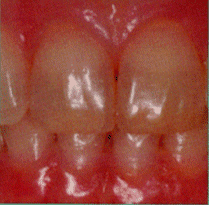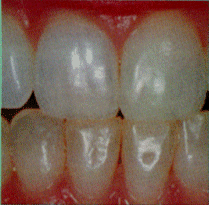
Dental Patient Education
|
Tooth Whitening |
|
|
||
|
Your face has 15 muscles that work together to make a smile. Like some people, though, you may avoid using these muscles because you are embarrassed by your discolored teeth. A simple procedure called bleaching may whiten your teeth and allow the real you to shine through. Why are my Teeth Discolored?Just as people have different skin and hair color, people also have different tooth color. Some teeth are more yellow, and some teeth yellow with aging. Natural tooth color can be discolored by a number of causes. The surface of the tooth can be stained by tobacco, certain foods and beverages such as coffee, tea and berries, and by deposits of calculus or tartar. Discoloration of the tooth internally can result from aging, injury, excessive fluoride, certain illnesses and taking the antibiotic tetracycline during early childhood. Although bleaching successfully lightens most discoloration, certain types (such as those caused by tetracycline) are more difficult to remove.
ProceduresThere are two types of bleaching procedures. Bleaching may be done completely in the dental office (known as chairside bleaching) or a system may be dispensed by the dentist for the patient to use at home (nightguard bleaching).
To protect the mouth, a gel-like substance is applied to the gums and a rubber "shield" is placed around the necks of the teeth. A chemical solution (the oxidizing agent) is then "painted" on the teeth. A special light may be used at five-minute intervals to help activate the agent.
Some people with certain dental conditions may not be good candidates for this type of bleaching. People with gum recession, for example, may have exposed root surfaces which are highly sensitive that could be further irritated by the ingredients in whiteners. In addition, these products are not recommended for habitual tobacco and alcohol users. Advantages of BleachingThe advantages of tooth bleaching over other procedures to whiten teeth are that it doesn't require any tooth structure to be removed and it is the most economical. Even teeth that have had root canals can be easily whitened. ResultsTo get the best results, teeth may be bleached a shade lighter than desired since they will tend to darken slightly with time. Anywhere from two to ten visits may be required to complete the process of chairside bleaching. Nightguard bleaching is normally intended to be completed in two weeks. Most bleaching lasts one to three years, although in some situations it may be longer. Your dentist will monitor the entire process of nightguard bleaching to assure its effectiveness and safety. Over-the-counter products which are self-administered are not recommended. Although they may appear to cost less, bleaching treatments should only be done under the supervision of a dentist following a proper examination and diagnosis of the discolored teeth. Whiteners with the ADA Seal of Acceptance have been proven to be safe and effective. With some chair-side techniques, you should avoid stain-causing beverages (such as tea and coffee) for several days after the procedure, because your teeth may more readily absorb stains at that time. Twice-daily brushing, daily flossing and regular professional cleanings -- along with occasional touch-up treatments -- will keep your teeth white so that you can once again feel confident in exercising your smile. |
||
|
|
||
| © Copyright 1996 - 2008 HIVdent.org. All Rights Reserved. | ||


 The
procedure that is done in the dental office takes from 30 minutes to one hour per visit.
It is not uncommon for the teeth to become slightly sensitive following bleaching
treatments.
The
procedure that is done in the dental office takes from 30 minutes to one hour per visit.
It is not uncommon for the teeth to become slightly sensitive following bleaching
treatments.  With
nightguard bleaching, an impression for a model of your teeth is made, and a custom-fitted
mouthguard is made. A bleaching agent in the form of a bleaching gel is then prescribed.
The gel is placed in a mouthguard and worn up to two hours daily or at night for about two
weeks. The amount of time the nightguard is worn and the duration may vary according to
your needs and your dentist's recommendations.
With
nightguard bleaching, an impression for a model of your teeth is made, and a custom-fitted
mouthguard is made. A bleaching agent in the form of a bleaching gel is then prescribed.
The gel is placed in a mouthguard and worn up to two hours daily or at night for about two
weeks. The amount of time the nightguard is worn and the duration may vary according to
your needs and your dentist's recommendations.